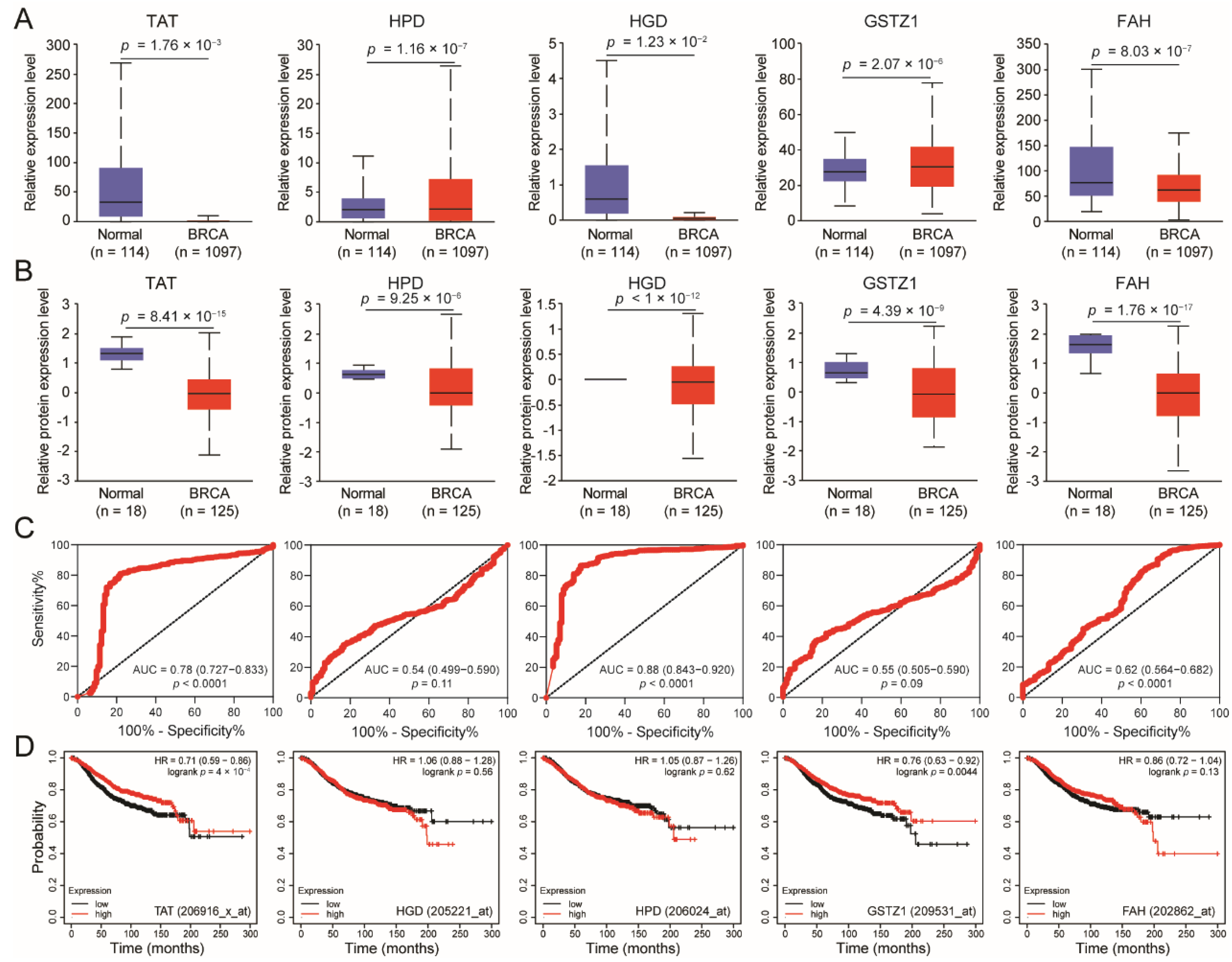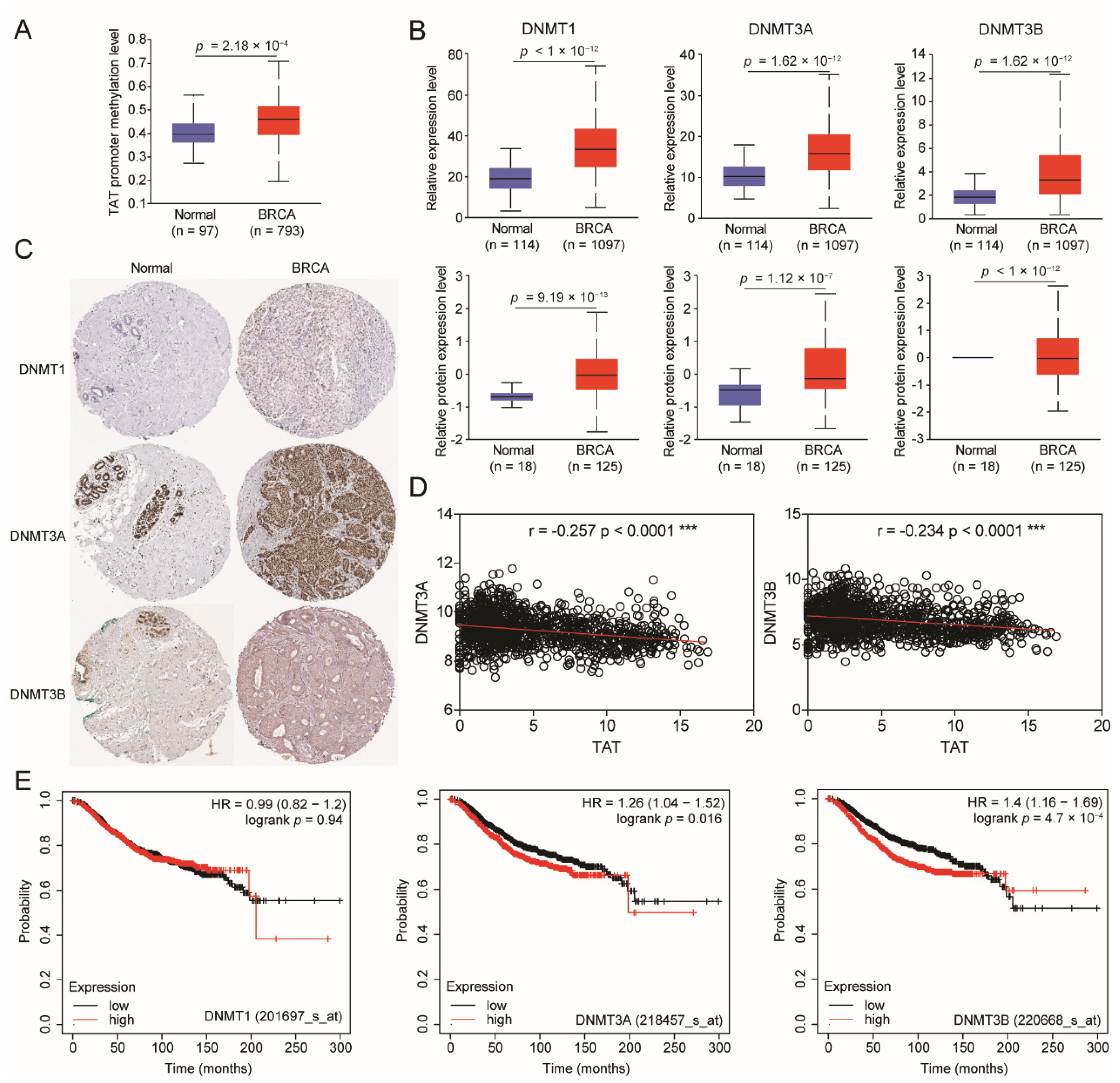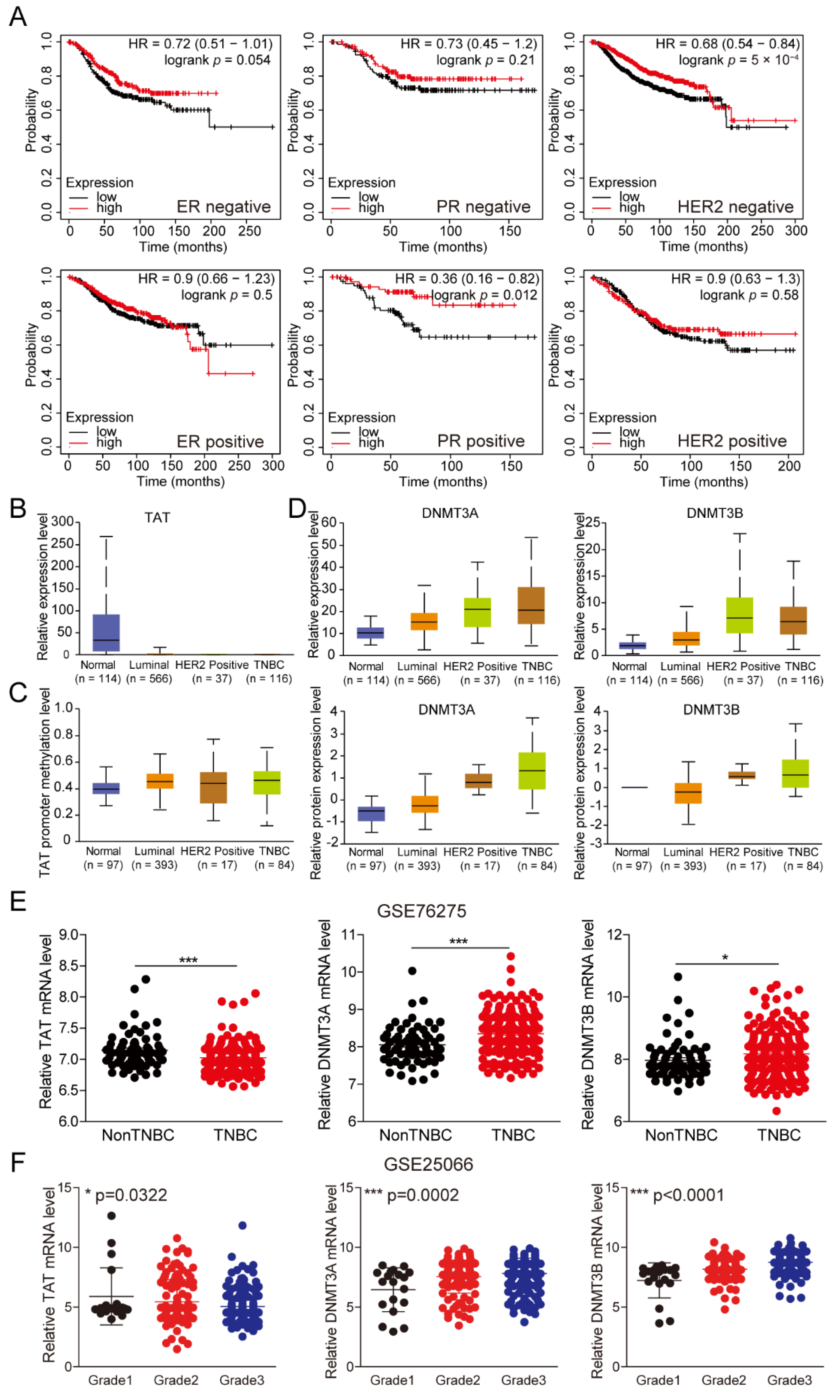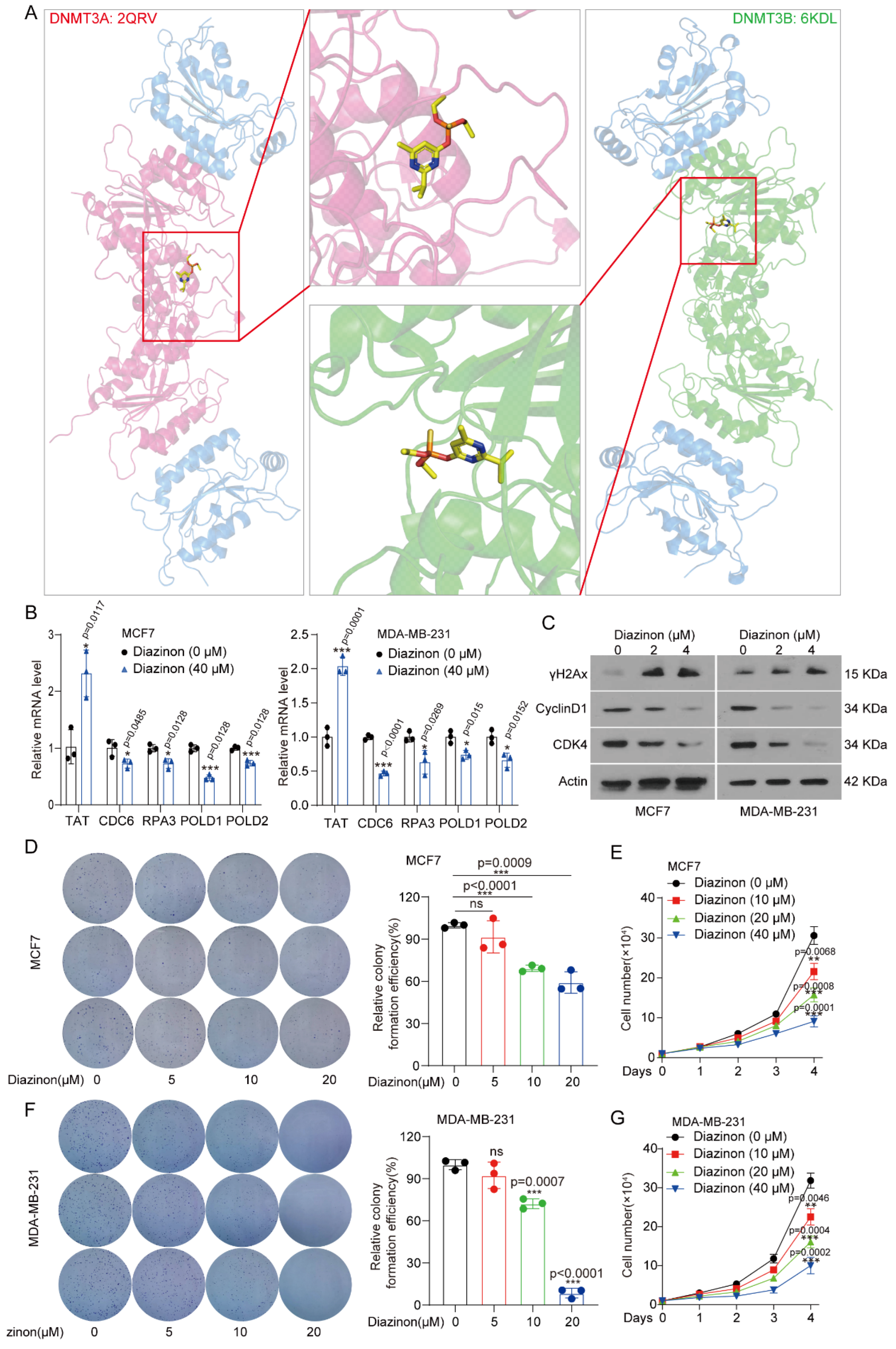Identification of TAT as a Biomarker Involved in Cell Cycle and DNA Repair in Breast Cancer
Abstract
1. Introduction
2. Materials and Methods
2.1. The Analysis for Differential Gene Expression and Promoter Methylation Level
2.2. Receiver Operating Characteristic (ROC) Curve
2.3. Kaplan–Meier Plotter (KM Plotter)
2.4. Human Protein Atlas (HPA)
2.5. Correlation Analysis of Gene Expression
2.6. Gene Expression Omnibus (GEO)
2.7. Gene Set Enrichment Analysis (GSEA)
2.8. Target Overlap Analysis
2.9. Molecular Docking
2.10. Cell Culture
2.11. RNA Extraction and Real-Time PCR Analysis (qPCR)
2.12. Cell Proliferation Assay
2.13. Western Blot
2.14. Colony Formation Assay
2.15. Reagent and Antibodies (Table 2)
| Reagent or Antibody | Source | Identifier |
|---|---|---|
| Diazinon | TargetMol | T0998 |
| TAT | Biodragon | BD-PE0222 |
| DNMT3A | Selleck | F1036 |
| DNMT3B | Selleck | F0001 |
| γH2Ax | ABclonal | AP0687 |
| CyclinD1 | proteintech | 60186-1-Ig |
| CDK4 | proteintech | 11026-1-AP |
| Actin | proteintech | 66009-1-Ig |
2.16. Statistics
3. Results
3.1. TAT Was Down-Regulated and Associated with Poor Prognosis in BC
3.2. TAT Promoter Was Methylated by DNMT3A and DNMT3B
3.3. DNMT3A and DNMT3B Reduce TAT Expression by Methylation of Its Promoter in Triple-Negative Breast Cancer
3.4. Reduced TAT Contributes to Activation of the Cell Cycle and Promotes DNA Repair
3.5. Targeting DNMT3A/3B Inhibits Proliferation of Breast Cancer Cells
4. Discussion
5. Conclusions
Supplementary Materials
Author Contributions
Funding
Institutional Review Board Statement
Informed Consent Statement
Data Availability Statement
Conflicts of Interest
References
- Akram, M.; Iqbal, M.; Daniyal, M.; Khan, A.U. Awareness and current knowledge of breast cancer. Biol. Res. 2017, 50, 33. [Google Scholar] [CrossRef] [PubMed]
- Kim, C.; Gao, R.; Sei, E.; Brandt, R.; Hartman, J.; Hatschek, T.; Crosetto, N.; Foukakis, T.; Navin, N.E. Chemoresistance Evolution in Triple-Negative Breast Cancer Delineated by Single-Cell Sequencing. Cell 2018, 173, 879–893.e13. [Google Scholar] [CrossRef] [PubMed]
- McDonald, E.S.; Clark, A.S.; Tchou, J.; Zhang, P.; Freedman, G.M. Clinical Diagnosis and Management of Breast Cancer. J. Nucl. Med. 2016, 57 (Suppl. S1), 9s–16s. [Google Scholar] [CrossRef] [PubMed]
- Zhang, M.; Chen, H.; Wang, M.; Bai, F.; Wu, K. Bioinformatics analysis of prognostic significance of COL10A1 in breast cancer. Biosci. Rep. 2020, 40, BSR20193286. [Google Scholar] [CrossRef]
- Hanahan, D. Hallmarks of Cancer: New Dimensions. Cancer Discov. 2022, 12, 31–46. [Google Scholar] [CrossRef]
- Sun, X.; Wang, M.; Wang, M.; Yu, X.; Guo, J.; Sun, T.; Li, X.; Yao, L.; Dong, H.; Xu, Y. Metabolic Reprogramming in Triple-Negative Breast Cancer. Front. Oncol. 2020, 10, 428. [Google Scholar] [CrossRef]
- Wang, Z.; Jiang, Q.; Dong, C. Metabolic reprogramming in triple-negative breast cancer. Cancer Biol. Med. 2020, 17, 44–59. [Google Scholar] [CrossRef] [PubMed]
- Zhao, Y.; Pu, C.; Jiao, D.; Zhu, J.; Guo, X.; Liu, Z. Essential amino acid metabolism-related molecular classification in triple-negative breast cancer. Epigenomics 2021, 13, 1247–1268. [Google Scholar] [CrossRef]
- Saberi Ansar, E.; Eslahchii, C.; Rahimi, M.; Geranpayeh, L.; Ebrahimi, M.; Aghdam, R.; Kerdivel, G. Significant random signatures reveals new biomarker for breast cancer. BMC Med. Genom. 2019, 12, 160. [Google Scholar] [CrossRef] [PubMed]
- Liu, H.; Song, Y.; Qiu, H.; Liu, Y.; Luo, K.; Yi, Y.; Jiang, G.; Lu, M.; Zhang, Z.; Yin, J.; et al. Downregulation of FOXO3a by DNMT1 promotes breast cancer stem cell properties and tumorigenesis. Cell Death Differ. 2020, 27, 966–983. [Google Scholar] [CrossRef]
- Zhang, J.; Zhang, F.; Zhang, F.; Wu, H.; Zhang, B.; Wu, X. Correlation between promoter methylation of the LDH-C4 gene and DNMT expression in breast cancer and their prognostic significance. Oncol. Lett. 2022, 23, 35. [Google Scholar] [CrossRef] [PubMed]
- Chequin, A.; Costa, L.E.; de Campos, F.F.; Moncada, A.D.B.; de Lima, L.T.F.; Sledz, L.R.; Picheth, G.F.; Adami, E.R.; Acco, A.; Gonçalves, M.B.; et al. Antitumoral activity of liraglutide, a new DNMT inhibitor in breast cancer cells in vitro and in vivo. Chem. Biol. Interact. 2021, 349, 109641. [Google Scholar] [CrossRef] [PubMed]
- Wong, K.K. DNMT1: A key drug target in triple-negative breast cancer. Semin. Cancer Biol. 2021, 72, 198–213. [Google Scholar] [CrossRef]
- Liang, F.; Zhang, H.; Gao, H.; Cheng, D.; Zhang, N.; Du, J.; Yue, J.; Du, P.; Zhao, B.; Yin, L. Liquiritigenin decreases tumorigenesis by inhibiting DNMT activity and increasing BC1 transcriptional activity in triple-negative breast cancer. Exp. Biol. Med. 2021, 246, 459–466. [Google Scholar] [CrossRef] [PubMed]
- Yu, J.; Qin, B.; Moyer, A.M.; Nowsheen, S.; Liu, T.; Qin, S.; Zhuang, Y.; Liu, D.; Lu, S.W.; Kalari, K.R.; et al. DNA methyltransferase expression in triple-negative breast cancer predicts sensitivity to decitabine. J. Clin. Investig. 2018, 128, 2376–2388. [Google Scholar] [CrossRef]
- Chandrashekar, D.S.; Karthikeyan, S.K.; Korla, P.K.; Patel, H.; Shovon, A.R.; Athar, M.; Netto, G.J.; Qin, Z.S.; Kumar, S.; Manne, U.; et al. UALCAN: An update to the integrated cancer data analysis platform. Neoplasia 2022, 25, 18–27. [Google Scholar] [CrossRef] [PubMed]
- Zhang, Y.; Chen, F.; Chandrashekar, D.S.; Varambally, S.; Creighton, C.J. Proteogenomic characterization of 2002 human cancers reveals pan-cancer molecular subtypes and associated pathways. Nat. Commun. 2022, 13, 2669. [Google Scholar] [CrossRef] [PubMed]
- Győrffy, B. Discovery and ranking of the most robust prognostic biomarkers in serous ovarian cancer. Geroscience 2023, 45, 1889–1898. [Google Scholar] [CrossRef]
- Uhlén, M.; Fagerberg, L.; Hallström, B.M.; Lindskog, C.; Oksvold, P.; Mardinoglu, A.; Sivertsson, Å.; Kampf, C.; Sjöstedt, E.; Asplund, A.; et al. Proteomics. Tissue-based map of the human proteome. Science 2015, 347, 1260419. [Google Scholar] [CrossRef]
- Wang, J.; Chang, H.; Su, M.; Qiao, Y.; Sun, H.; Zhao, Y.; Zhang, S.; Shan, C. Identification of HGD and GSTZ1 as Biomarkers Involved Metabolic Reprogramming in Kidney Renal Clear Cell Carcinoma. Int. J. Mol. Sci. 2022, 23, 4583. [Google Scholar] [CrossRef]
- Wang, J.; Qiao, Y.; Sun, H.; Chang, H.; Zhao, H.; Zhang, S.; Shan, C. Decreased SLC27A5 Suppresses Lipid Synthesis and Tyrosine Metabolism to Activate the Cell Cycle in Hepatocellular Carcinoma. Biomedicines 2022, 10, 234. [Google Scholar] [CrossRef] [PubMed]
- Nishiyama, A.; Nakanishi, M. Navigating the DNA methylation landscape of cancer. Trends Genet. 2021, 37, 1012–1027. [Google Scholar] [CrossRef] [PubMed]
- Sendinc, E.; Shi, Y. RNA m6A methylation across the transcriptome. Mol. Cell 2023, 83, 428–441. [Google Scholar] [CrossRef]
- Kulis, M.; Esteller, M. DNA methylation and cancer. Adv. Genet. 2010, 70, 27–56. [Google Scholar] [PubMed]
- Li, E.; Bestor, T.H.; Jaenisch, R. Targeted mutation of the DNA methyltransferase gene results in embryonic lethality. Cell 1992, 69, 915–926. [Google Scholar] [CrossRef] [PubMed]
- Okano, M.; Bell, D.W.; Haber, D.A.; Li, E. DNA methyltransferases Dnmt3a and Dnmt3b are essential for de novo methylation and mammalian development. Cell 1999, 99, 247–257. [Google Scholar] [CrossRef]
- Yeo, S.K.; Guan, J.L. Breast Cancer: Multiple Subtypes within a Tumor? Trends Cancer 2017, 3, 753–760. [Google Scholar] [CrossRef] [PubMed]
- Yin, L.; Duan, J.J.; Bian, X.W.; Yu, S.C. Triple-negative breast cancer molecular subtyping and treatment progress. Breast Cancer Res. 2020, 22, 61. [Google Scholar] [CrossRef] [PubMed]
- Bai, X.; Ni, J.; Beretov, J.; Graham, P.; Li, Y. Triple-negative breast cancer therapeutic resistance: Where is the Achilles’ heel? Cancer Lett. 2021, 497, 100–111. [Google Scholar] [CrossRef]
- Wu, Z.; Wu, J.; Zhao, Q. Emerging roles of aerobic glycolysis in breast cancer. Clin. Transl. Oncol. 2020, 22, 631–646. [Google Scholar] [CrossRef]
- Carracedo, A.; Weiss, D.; Leliaert, A.K.; Bhasin, M.; de Boer, V.C.; Laurent, G.; Adams, A.C.; Sundvall, M.; Song, S.J.; Ito, K.; et al. A metabolic prosurvival role for PML in breast cancer. J. Clin. Investig. 2012, 122, 3088–3100. [Google Scholar] [CrossRef] [PubMed]
- Cao, M.D.; Lamichhane, S.; Lundgren, S.; Bofin, A.; Fjøsne, H.; Giskeødegård, G.F.; Bathen, T.F. Metabolic characterization of triple negative breast cancer. BMC Cancer 2014, 14, 941. [Google Scholar] [CrossRef] [PubMed]
- Pollari, S.; Käkönen, S.M.; Edgren, H.; Wolf, M.; Kohonen, P.; Sara, H.; Guise, T.; Nees, M.; Kallioniemi, O. Enhanced serine production by bone metastatic breast cancer cells stimulates osteoclastogenesis. Breast Cancer Res. Treat. 2011, 125, 421–430. [Google Scholar] [CrossRef] [PubMed]
- Lanzardo, S.; Conti, L.; Rooke, R.; Ruiu, R.; Accart, N.; Bolli, E.; Arigoni, M.; Macagno, M.; Barrera, G.; Pizzimenti, S.; et al. Immunotargeting of Antigen xCT Attenuates Stem-like Cell Behavior and Metastatic Progression in Breast Cancer. Cancer Res. 2016, 76, 62–72. [Google Scholar] [CrossRef] [PubMed]
- Muthusamy, T.; Cordes, T.; Handzlik, M.K. Serine restriction alters sphingolipid diversity to constrain tumour growth. Nature 2020, 586, 790–795. [Google Scholar] [CrossRef]






| Gene | Sequence (5′→3′) |
|---|---|
| TAT | Primer-F: CTGGACTCGGGCAAATATAATGG Primer-R: GTCCTTAGCTTCTAGGGGTGC |
| CDC6 | Primer-F: CCAGGCACAGGCTACAATCAG Primer-R: AACAGGTTACGGTTTGGACATT |
| RPA3 | Primer-F: AGCTCAATTCATCGACAAGCC Primer-R: TCTTCATCAAGGGGTTCCATCA |
| POLD1 | Primer-F: CAGTGCCAAGGTGGTGTATGG Primer-R: CTTGCTGATAAGCAGGTATGGG |
| POLD2 | Primer-F: CAGCGTATCAAACTAAAAGGCAC Primer-R: GTCTCTCACGGAGCCAAACAC |
| ACTIN | Primer-F: GGAAATCGTGCGTGACAT Primer-R: TGCCAATGGTGATGACCT |
Disclaimer/Publisher’s Note: The statements, opinions and data contained in all publications are solely those of the individual author(s) and contributor(s) and not of MDPI and/or the editor(s). MDPI and/or the editor(s) disclaim responsibility for any injury to people or property resulting from any ideas, methods, instructions or products referred to in the content. |
© 2024 by the authors. Licensee MDPI, Basel, Switzerland. This article is an open access article distributed under the terms and conditions of the Creative Commons Attribution (CC BY) license (https://creativecommons.org/licenses/by/4.0/).
Share and Cite
Xie, F.; Hua, S.; Guo, Y.; Wang, T.; Shan, C.; Zhang, L.; He, T. Identification of TAT as a Biomarker Involved in Cell Cycle and DNA Repair in Breast Cancer. Biomolecules 2024, 14, 1088. https://doi.org/10.3390/biom14091088
Xie F, Hua S, Guo Y, Wang T, Shan C, Zhang L, He T. Identification of TAT as a Biomarker Involved in Cell Cycle and DNA Repair in Breast Cancer. Biomolecules. 2024; 14(9):1088. https://doi.org/10.3390/biom14091088
Chicago/Turabian StyleXie, Fei, Saiwei Hua, Yajuan Guo, Taoyuan Wang, Changliang Shan, Lianwen Zhang, and Tao He. 2024. "Identification of TAT as a Biomarker Involved in Cell Cycle and DNA Repair in Breast Cancer" Biomolecules 14, no. 9: 1088. https://doi.org/10.3390/biom14091088
APA StyleXie, F., Hua, S., Guo, Y., Wang, T., Shan, C., Zhang, L., & He, T. (2024). Identification of TAT as a Biomarker Involved in Cell Cycle and DNA Repair in Breast Cancer. Biomolecules, 14(9), 1088. https://doi.org/10.3390/biom14091088






